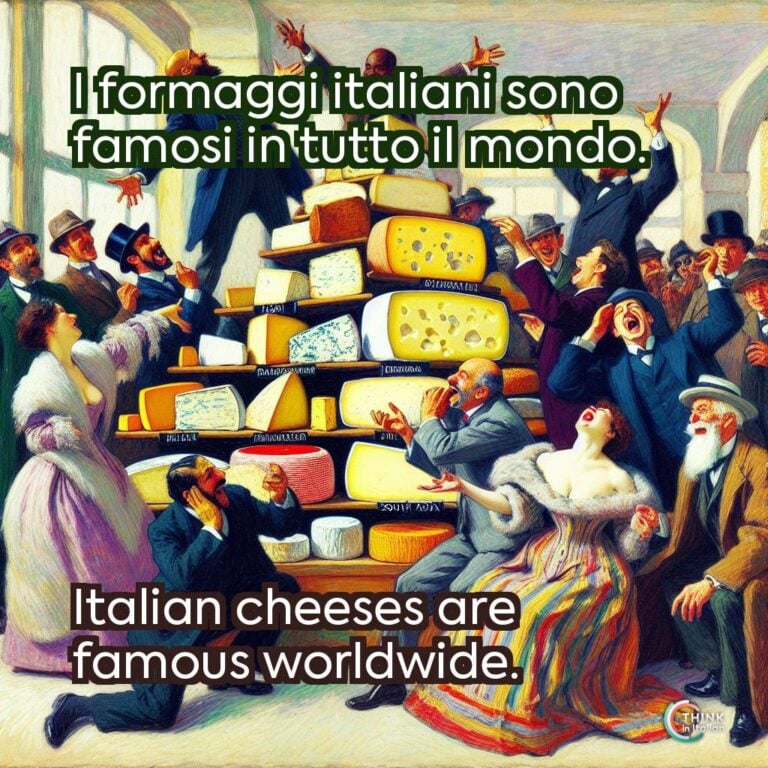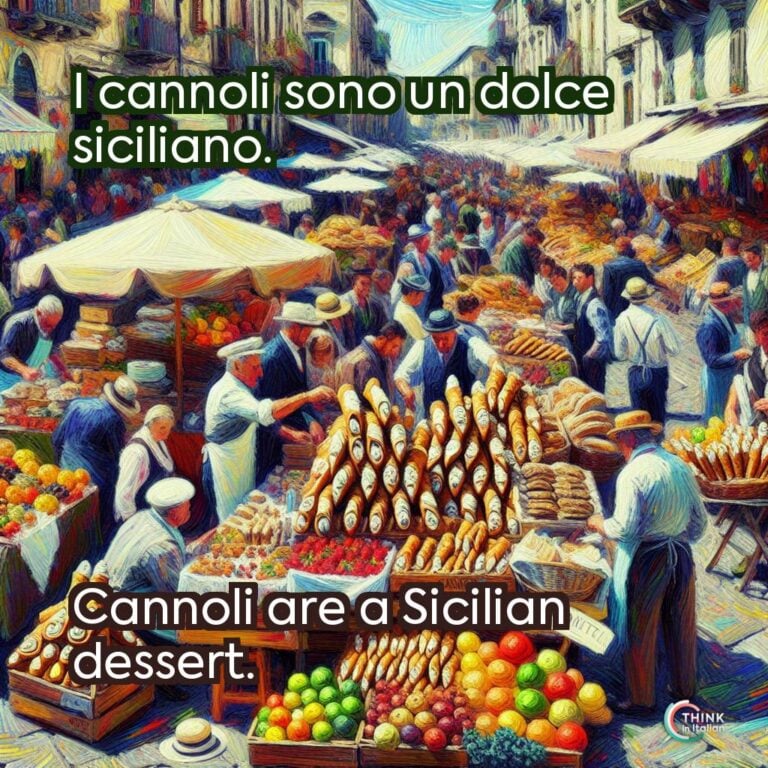Why Learn Italian Food Vocabulary?
Learning Italian vocabulary about food is not only learning a list of words: it’s a key to Italy’s rich culinary culture.
Whether ordering at a trattoria, at the market, or cooking up authentic dishes in your home kitchen, mastering the terminology elevates the experience and connects you with Italian traditions.
In this guide, I will cover some basics, highlight practical scenarios, and also review idiomatic expressions so that you learn everything you need to know about Italian vocabulary related to food.
Italian Food Vocabulary
Essential Italian Food Vocabulary
Start with the basics to navigate menus and conversations with confidence:
- Il cibo – Food
- Il pasto – Meal
- Mangiare – To eat
- Bere – To drink
- Fame – Hunger (Ho fame – I’m hungry)
- Sete – Thirst (Ho sete – I’m thirsty)
- Pranzo – Lunch
- Cena – Dinner
- Tavolo – Table
Italian Food Categories
- Antipasti – Appetizers
- Bruschetta – Toasted bread with tomatoes, olive oil, and garlic
- Crostini – Small slices of bread with toppings
- Prosciutto – Thinly sliced cured ham
- Salumi – Various cured meats
- Formaggi – Cheeses
- Olive – Olives
- Polpette – Meatballs
- Frittata – Italian omelet
- Insalata Caprese – Tomato and mozzarella salad
- Pasta – Pasta
- Pizza – Pizza
- Margherita – Tomato sauce, mozzarella, and basil
- Quattro formaggi – Pizza with four cheeses
- Prosciutto e funghi – Pizza with ham and mushrooms
- Focaccia – Flatbread
- Pane – Bread
- Carne – Meat
- Manzo – Beef
- Vitello – Veal
- Maiale – Pork
- Agnello – Lamb
- Pesce – Fish
- Gamberi – Shrimp
- Calamari – Squid
- Vongole – Clams
- Cozze – Mussels
- Verdure – Vegetables
- Insalata – Salad
- Pomodoro – Tomato
- Cetriolo – Cucumber
- Lattuga – Lettuce
- Rucola – Arugula
- Carciofi – Artichokes
- Melanzane – Eggplant
- Funghi – Mushrooms
- Zucchine – Zucchini
- Formaggi – Cheese
- Parmigiano-Reggiano – Hard, aged cheese
- Mozzarella – Soft cheese used in pizza
- Ricotta – Creamy cheese
- Gorgonzola – Blue cheese
- Latte – Milk
- Burro – Butter
- Panna – Cream
- Mascarpone – Cream cheese used in tiramisu
- Dolce – Dessert
- Gelato – Italian ice cream
- Tiramisù – Coffee-soaked ladyfingers layered with mascarpone cream
- Cannoli – Pastry filled with sweet ricotta cream
- Panna cotta – Creamy, custard-like dessert
- Crostata – Italian tart
- Panettone – Sweet bread with dried fruit
- Biscotti – Hard, twice-baked cookies
- Cioccolato – Chocolate
Practical Scenarios for Using Italian Food Vocabulary
At an Italian Market
Markets in Italy are lively places brimming with fresh produce, meats, cheeses, and specialty goods. Knowing how to communicate with vendors will make your experience seamless and enjoyable.
Posso avere un chilo di pomodori, per favore?
Can I have a kilo of tomatoes, please?
Quanto costa questo formaggio?
How much does this cheese cost?
Ci sono sconti per questi carciofi?
Are there any discounts on these artichokes?
Mi dia mezzo chilo di zucchine, per favore.
Give me half a kilo of zucchinis, please.
Questo prosciutto è crudo o cotto?
Is this ham raw or cooked?
Dining at a Trattoria
Dining out is a cornerstone of Italian culture. Using specific food vocabulary will help you better communicate and elevate your experience.
Cosa mi consiglia?
What do you recommend?
Vorrei ordinare spaghetti alle vongole e una insalata verde.
I’d like to order spaghetti with clams and a green salad.
Posso avere un po’ di olio?
Could I have a bit of olive oil?
Vorrei il piatto senza formaggio.
I’d like the dish without cheese.
Il conto, per favore.
The bill, please.
Avete dolci della casa?
Do you have any house-made desserts?
Cooking at Home
Learning Italian food vocabulary can make following recipes and cooking authentic dishes much easier.
Taglia i pomodori a dadini.
Dice the tomatoes.
Aggiungi una spruzzata di limone sul pesce.
Add a splash of lemon on the fish.
Cuoci la pasta al dente.
Cook the pasta al dente.
Mescola la salsa lentamente.
Stir the sauce slowly.
Socializing Over Food
In Italian culture, meals are social events. Being able to participate in food-related conversations adds to your cultural immersion.
Hai mai provato la pasta alla norma?
Have you ever tried pasta alla norma?
Questa focaccia è davvero buonissima!
This focaccia is really delicious!
Qual è il tuo vino preferito con i formaggi?
What’s your favorite wine with cheese?
Questa gelateria è famosa per il suo pistacchio.
This gelato shop is famous for its pistachio flavor.
Idioms Using Food Vocabulary
Not only do food-related idioms enhance your language skills, but they also give insight into Italian culture and humor. Here are more examples with explanations and contexts:
- Essere come il prezzemolo (To be like parsley): refers to someone or something that shows up everywhere, often unnecessarily. For instance, someone always inserts themselves into conversations:
Mario è come il prezzemolo, è ovunque!
Mario is like parsley, he’s everywhere!
- Avere il prosciutto sugli occhi (To have ham over your eyes): means to be blind to the obvious. For example, when someone fails to notice something clear.
Non vedi che ti sta mentendo? Hai il prosciutto sugli occhi!
Can’t you see he’s lying to you? You’ve got ham over your eyes!
- Non tutte le ciambelle riescono col buco (Not all donuts come out with a hole): reminds us that not everything goes as planned. Imagine a project or event that doesn’t turn out perfectly:
Il mio pane non è venuto bene, ma non tutte le ciambelle riescono col buco.
My bread didn’t turn out well, but not all donuts come out with a hole.
- Andare a tutta birra (To go at full beer): means to go full speed or with great energy. Use it when describing someone working or moving very fast.
Consegnerò il progetto in tempo perché sto andando a tutta birra!
I’ll deliver the project on time because I’m going full speed!
- Tutto fa brodo (Everything makes broth): suggests that even small contributions matter, like when someone offers a small but useful contribution.
Anche se hai donato poco, tutto fa brodo.
Even if you donated a little, everything makes broth.
- Essere fritto (To be fried): refers to being in big trouble or beyond saving. For example, when someone is in a hopeless situation.
Se non studio, sono fritto per l’esame di domani.
If I don’t study, I’m fried for tomorrow’s exam.
- Farne di cotte e di crude (To do cooked and raw things): refers to doing all sorts of wild or outrageous things, use to describe someone’s misadventures.
Durante le vacanze ne hanno fatte di cotte e di crude.
During the holidays, they got up to all sorts of antics.






